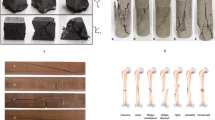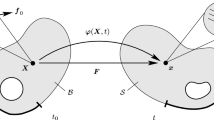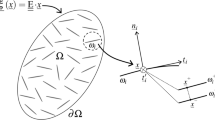Abstract
The nature of fracture in most engineering materials exhibits the inherent anisotropy. Assuming isotropic evolution of fracture in such anisotropic materials is no longer consistent. It is because that the principles and fundamental issues that behind the directional-dependent fracture mechanism are still interrogative. In this paper, the recently developed mass-field damage model for brittle fracture in isotropic materials is extended to account for anisotropic crack propagation in transversely isotropic materials. To model a unidirectional fiber-reinforced composite, the fiber orientation characterizing deformation between the reference and current configurations is thus defined in terms of a scalar fiber-stretch factor through the anisotropic strain energy density (SED). The significance of the study lies in the development of a new variant for the constitutive law for mass flux to be able to deal with directional-dependent fracture in solids. To this end, the pure forms of mass source and mass flux are thus revisited so as to possibly capture the anisotropy, i.e., a novel constitutive law for the spatial mass flux is defined by additionally introducing a second-order structural tensor, which is a function of the anisotropic coefficient and fiber directions controlling the anisotropy of directional fracture. Consequently, in contrast to the traditional local mass-balance equation for isotropic materials, the new form of the locally diffusive mass-balance equation controlling the evolution of mass density is now incorporated an anisotropic spatial mass flux function instead. In addition, we also explore the characteristics of the anisotropic length scale parameter in the context of directional-dependent fracture analysis. Another novelty is devoted to the energy decomposition for the mass-balance equation of the SED for anisotropic materials, i.e., the anisotropic part of the SED is described in terms of the first invariant of the right Cauchy–Green deformation tensor and another material parameter related to the reinforced fibers. The finite element discretization associated with a staggered solution algorithm for anisotropic brittle fracture is described. The merits of the developed anisotropic fracture model are illustrated via numerical examples under quasi-static loading condition.













Similar content being viewed by others
Change history
01 April 2022
A Correction to this paper has been published: https://doi.org/10.1007/s00707-022-03180-z
Notes
Since the deleted element method is adopted in this work, the term \(\mathcal {H}\text {exp}\left[ -\left( \frac{{W^e}^+}{\Phi } \right) ^m \right] \) in the constitutive laws for mass source and mass flux represent the variations of density at element level. Another thing should be noticed that the evolution of the switch parameter in Eq. (10) can be interpreted as \(\dot{\zeta } = -H\left( \epsilon - \frac{\psi _e}{\psi _\mathrm{f}}\right) , \zeta \left( t = 0\right) = 0\), [36] with \(\psi _\mathrm{f}\) being the constant bulk failure energy and \(\psi _{e}(\varvec{F})\) describing the elastic energy at element level, see [36] for their definitions.
References
Sih, G.C., Paris, P.C., Irwin, G.R.: On cracks in rectilinearly anisotropic bodies. Int. J. Fract .Mech. 1, 198–203 (1965)
Barnett, D.M., Asaro, R.J.: The fracture mechanics of slit-like cracks in anisotropic elastic media. J. Mech. Phys. Solids 20, 353–366 (1972)
Stroh, A.N.: Dislocations and cracks in anisotropic elasticity. Philos. Mag. 3, 625–646 (1958)
Cahill, L.M., Natarajan, S., Bordas, S.P.A., O’Higgins, R., Mccarthy, C.T.: An experimental/numerical investigation into the main driving force for crack propagation in uni-directional fibre-reinforced composite laminae. Compos. Struct. 107, 119–130 (2014)
Bui, T.Q., Zhang, C.: Extended finite element simulation of stationary dynamic cracks in piezoelectric solids under impact loading. Comput. Mater. Sci. 62, 243–257 (2012)
Bui, T.Q., Zhang, C.: Analysis of generalized dynamic intensity factors of cracked magnetoelectroelastic solids by X-FEM. Finite Elem. Anal. Des. 69, 19–36 (2013)
Gao, Y., Liu, Z., Wang, T., Zeng, Q., Li, X., Zhuang, Z.: XFEM modeling for curved fracture in the anisotropic fracture toughness medium. Comput. Mech. 63, 869–883 (2019)
Kuhl, E., Ramm, E., de Borst, R.: An anisotropic gradient damage model for quasi-brittle materials. Comput. Methods Appl. Mech. Eng. 183, 87–103 (2000)
Desmorat, R., Gatuingt, F., Ragueneau, F.: Nonlocal anisotropic damage model and related computational aspects for quasi-brittle materials. Eng. Fract. Mech. 74, 1539–1560 (2007)
Pena, E.: A rate dependent directional damage model for fibred materials: application to soft biological tissues. Comput. Mech. 48, 407–420 (2011)
Nedjar, B.: On a concept of directional damage gradient in transversely isotropic materials. Int. J. Solids Struct. 88–89, 56–67 (2016)
Clayton, J., Knap, J.: Phase field modeling of directional fracture in anisotropic polycrystals. Comput. Mater. Sci. 98, 158–169 (2015)
Teichtmeister, S., Kienle, D., Aldakheel, F., Keip, M.-A.: Phase field modeling of fracture in anisotropic brittle solids. Int. J. Non Linear Mech. 97, 1–21 (2017)
Liu, Z.-K., Juhre, D.: Phase-Field modelling of crack propagation in anisotropic polycrystalline materials. Tech. Mech. 38(3), 286–299 (2018)
Li, B., Maurini, C.: Crack kinking in a variational phase-field model of brittle fracture with strongly anisotropic surface energy. J. Mech. Phys. Solids 125, 502–522 (2019)
Denli, F.A., Gültekin, O., Holzapfel, G.A., Dal, H.: A phase-field model for fracture of unidirectional fiber-reinforced polymer matrix composites. Comput. Mech. 65, 1149–1166 (2020)
Gmati, H., Mareau, C., Ammar, A., Arem, S.E.: A phase-field model for brittle fracture of anisotropic materials. Int. J. Numer. Methods Eng. 121, 3362–3381 (2020)
Bui, T.Q., Hu, X.F.: A review of phase-field models, fundamentals and their applications to composite laminates. Eng. Fract. Mech. 248, 107705 (2021)
Rezaei, S., Mianroodi, J.R., Brepols, T., Reese, S.: Direction-dependent fracture in solids: atomistically calibrated phase-field and cohesive zone model. J. Mech. Phys. Solids 147, 104253 (2021)
He, B., Schuler, L., Newell, P.: A numerical-homogenization based phase-field fracture modeling of linear elastic heterogeneous porous media. Comput. Mater. Sci. 176, 109519 (2020)
Zhang, P., Hu, X., Bui, T.Q., Yao, W.: Phase field modeling of fracture in fiber reinforced composite laminates. Int. J. Mech. Sci. 161–162, 105008 (2019)
Nguyen, T.T., Rethore, J., Baietto, M.C.: Phase field modelling of anisotropic crack propagation. Eur. J. Mech. A/Solids 65, 279–288 (2017)
Bleyer, J., Alessi, R.: Phase-field modeling of anisotropic brittle fracture including several damage mechanisms. Comput. Methods Appl. Mech. Eng. 336, 213–236 (2018)
Volokh, K.Y.: Fracture as a material sink. Mater. Theory 1(3), 9 (2017)
Faye, A., Lev, Y., Volokh, K.Y.: The effect of local inertia around the crack-tip in dynamic fracture of soft materials. Mech. Soft Mater. 1(1), 4 (2019)
Bui, T.Q., Tran, H.T.: A localized mass-field damage model with energy decomposition: formulation and FE implementation. Comput. Methods Appl. Mech. Eng. 387, 114134 (2021)
Tang, S., Zhang, G., Guo, T.F., Gou, X., Liu, W.K.: Phase field modeling of fracture in nonlinearly elastic solids via energy decomposition. Comput. Methods Appl. Mech. Eng. 347, 477–494 (2019)
Francfort, G.A., Marigo, J.-J.: Revisiting brittle fracture as an energy minimization problem. J. Mech. Phys. Solids 46(8), 1319–1342 (1998)
Nguyen, T.H.A., Bui, T.Q., Hirose, S.: Smoothing gradient damage model with evolving anisotropic nonlocal interactions tailored to low-order finite elements. Comput. Methods Appl. Mech. Eng. 328, 498–541 (2018)
Gao, Y., Liu, Z., Zeng, Q., Wang, T., Zhuang, Z., Hwang, K.C.: Theoretical and numerical prediction of crack path in the material with anisotropic fracture toughness. Eng. Fract. Mech. 180, 330–347 (2017)
Hakim, V., Karma, A.: Crack path prediction in anisotropic brittle materials. Phys. Rev. Lett. 95, 235501 (2005)
Holzapfel, G.A.: Nonlinear Solid Mechanics: A Continuum Approach for Engineering. Wiley, Hoboken (2000)
Volokh, K.Y.: On modeling failure of rubber-like materials. Mech. Res. Commun. 37(8), 684–689 (2010)
Gültekin, O., Dal, H., Holzapfel, G.A.: Numerical aspects of anisotropic failure in soft biological tissues favor energy-based criteria: a rate-dependent anisotropic crack phase-field model. Comput. Methods Appl. Mech. Eng. 331, 23–52 (2018)
Song, J.H., Wang, H., Belytschko, T.: A comparative study on finite element methods for dynamic fracture. Comput. Mech. 42, 239–250 (2008)
Volokh, K.Y.: Mechanics of Soft Materials. Springer, Singapore (2019)
Paggi, M., Corrado, M., Reinoso, J.: Fracture of solar-grade anisotropic polycrystalline silicon: a combined phase field-cohesive zone model approach. Comput. Methods Appl. Mech. Eng. 330, 123–148 (2018)
Acknowledgements
Hung Thanh Tran is gratefully acknowledged the Japanese Government MEXT scholarship for his Integrated Doctoral Education Program.
Author information
Authors and Affiliations
Corresponding author
Additional information
Publisher's Note
Springer Nature remains neutral with regard to jurisdictional claims in published maps and institutional affiliations.
The original online version of this article was revised: In the original article few corrections were missed and this has been corrected now.
Rights and permissions
About this article
Cite this article
Tran, H.T., Bui, T.Q. A directional-dependent localized mass-field damage model for anisotropic brittle fracture. Acta Mech 233, 1317–1336 (2022). https://doi.org/10.1007/s00707-022-03147-0
Received:
Revised:
Accepted:
Published:
Issue Date:
DOI: https://doi.org/10.1007/s00707-022-03147-0




